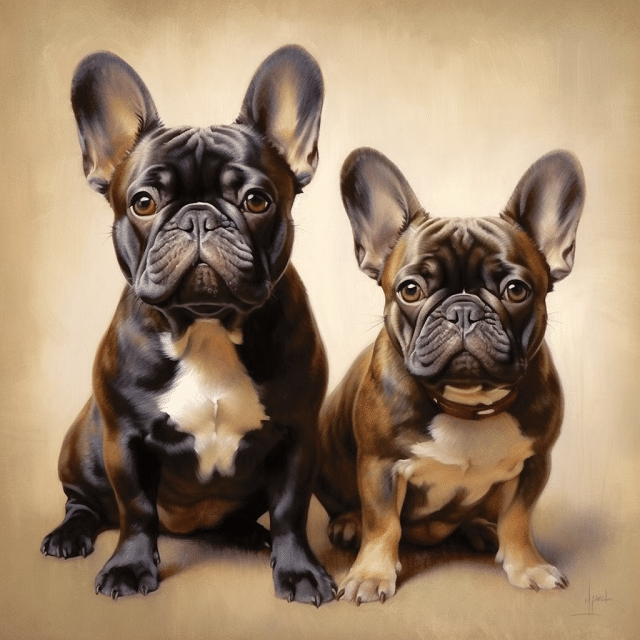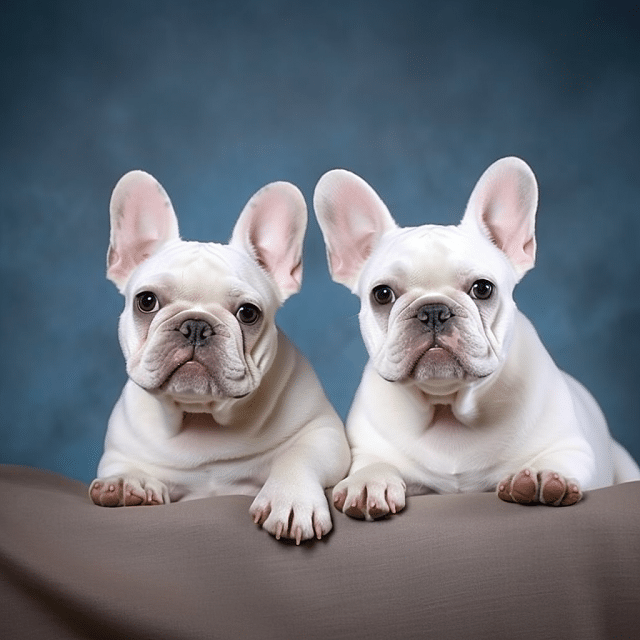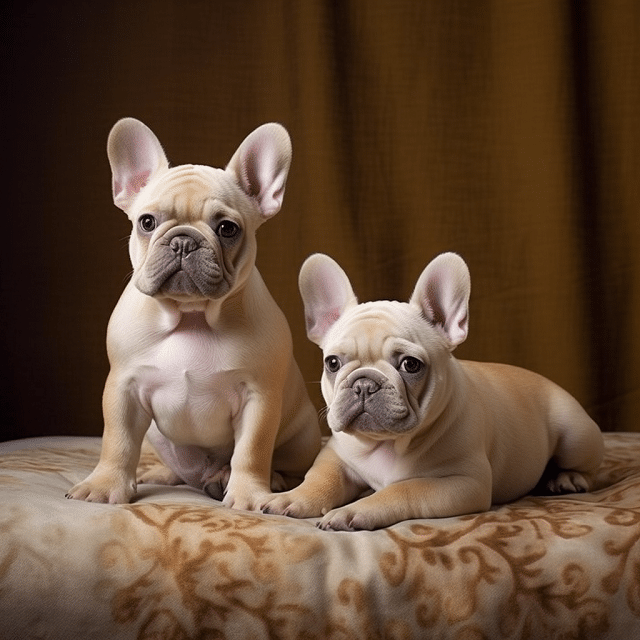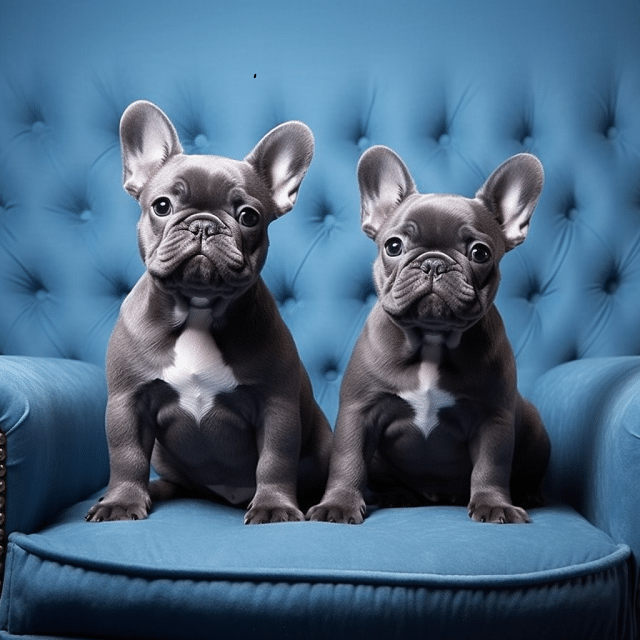French Bulldogs, affectionately known as Frenchies, are renowned for their unique and diverse coat colors. This breed, which originated in the 1800s as a miniature version of the English Bulldog, has since evolved into a symbol of elegance and style, partly due to its vibrant and varied color palette. The color of a Frenchie’s coat is more than just a visual trait; it’s a fascinating aspect of their genetics, personality, and health.
Recognized French Bulldog Colors
The American Kennel Club (AKC), the primary authority on dog breeds in the United States, officially recognizes four colors for French Bulldogs: brindle, fawn, white, and cream.
Brindle French Bulldogs
Brindle Frenchies have a coat that’s primarily dark with light strands mixed in, giving them a tiger-stripe or patchwork appearance. This pattern is caused by the interaction of specific genes, resulting in a unique and beautiful coat.

Fawn French Bulldogs
Fawn French Bulldogs have a solid coat that can range from a light tan to a dark reddish color. This color is often accompanied by a black mask around the face, which provides a striking contrast to the lighter body color.

White French Bulldogs
White Frenchies are known for their pure, snowy coats. This color can range from stark white to a light cream, and it often gives these dogs a regal and sophisticated appearance.

Cream French Bulldogs
Cream French Bulldogs have a slightly darker coat than white Frenchies, often described as a light gold or beige. This color gives them a warm and inviting appearance, making them a favorite among many Frenchie lovers.

Rare French Bulldog Colors
In addition to the four recognized colors, French Bulldogs can also come in a variety of rare and unique colors. These include blue, chocolate, lilac, and merle.
Blue French Bulldogs
Blue French Bulldogs have a coat that ranges from a light silvery blue to a deep, rich gray. This color is caused by a rare genetic trait known as dilution, which reduces the intensity of the black pigment in the dog’s coat.

Chocolate French Bulldogs
Chocolate French Bulldogs have a rich, dark brown coat that’s reminiscent of a delicious piece of chocolate. This color is caused by a recessive gene, meaning both parents must carry the gene for a pup to be chocolate.

Lilac French Bulldogs
Lilac French Bulldogs are truly unique, with a coat that has a distinct purple or silvery hue. This color is the result of a combination of the blue and chocolate genes, and it’s one of the rarest colors you’ll find in Frenchies.

Merle French Bulldogs
Merle French Bulldogs have a patterned coat that consists of a base color (like fawn or cream) with patches of darker color mixed in. This striking pattern is caused by the merle gene, which“`markdown
alters the pigmentation of the coat.
Controversies Surrounding Rare Colors
While these rare colors can be visually stunning, they’re also the subject of some controversy. Certain rare colors are associated with health issues. For example, dogs with the merle gene can have an increased risk of deafness and eye problems. In addition, there are ethical concerns about breeding for these rare colors. Some breeders may prioritize color over health, leading to unhealthy dogs. It’s essential for potential owners to research and choose responsible breeders who prioritize the health and well-being of their dogs.
Health Issues Associated with Rare Colors
Certain rare colors in French Bulldogs are linked to health problems due to the specific genes that cause these colors. For instance, the merle gene, which causes a mottled coat pattern, is associated with a range of health issues. Dogs with the merle gene can have an increased risk of deafness and eye problems, including increased intraocular pressure and colobomas, which are gaps in parts of the eyes.
Blue French Bulldogs, while admired for their unique coat color, can suffer from a condition known as Color Dilution Alopecia (CDA). This condition, caused by the dilution gene that produces the blue color, can lead to hair loss and skin problems.
Ethical Concerns in Breeding for Rare Colors
Breeding for specific, rare coat colors raises ethical concerns. Some breeders may prioritize the production of rare colors over the health and well-being of the dogs. This can lead to practices such as inbreeding or breeding dogs with known health issues to achieve the desired color, both of which can result in puppies with serious health problems and shortened lifespans.
Moreover, the high demand and price tag attached to these rare-colored French Bulldogs can encourage irresponsible breeding practices. Unscrupulous breeders might focus on profit over welfare, leading to overbreeding and neglect of the dogs’ health needs.
It’s crucial for potential owners to be aware of these issues when considering a rare-colored French Bulldog. Always research and choose responsible breeders who prioritize the health and well-being of their dogs over the coat color. Ask about the health of the parents and the puppies, and request to see health clearances where applicable. Remember, a responsible breeder will be just as interested in the welfare of the puppies they sell as you are.
Understanding Dog Coat Color Genetics
Before we delve into the specific colors of French Bulldogs, it’s crucial to understand the basic principles of dog coat color genetics. Just like in humans, a dog’s coat color is determined by its genes. Each pup receives one set of genes from each parent, which then combine to determine the color of the dog’s coat.
In the world of genetics, there are dominant and recessive genes. Dominant genes show their effect even if there is only one copy of that gene in the pair inherited from the parents. Recessive genes, on the other hand, only show their effect if both copies of the gene are the same.
In French Bulldogs, the genetics of coat color can be particularly complex due to the wide range of potential colors, each determined by different combinations of genes. For example, the gene that causes a Frenchie to be brindle is different from the one that causes it to be fawn, white, or cream.
The brindle color in French Bulldogs is caused by the K locus gene. If a Frenchie inherits the dominant version of this gene (denoted as “K”), it will be brindle. If it inherits the recessive version (“k”), it will not be brindle. However, the actual color of the brindle pattern (whether it’s black, brown, etc.) is determined by other genes.
The fawn color in French Bulldogs is often associated with the Ay allele on the A locus. This allele is dominant, so a Frenchie only needs to inherit one copy of it to be fawn. However, the intensity of the fawn color can be influenced by other genes.
The white and cream colors in French Bulldogs are often associated with the E and B loci. The E locus controls the production of eumelanin (black/brown pigment) and pheomelanin (red/yellow pigment) in the dog’s coat. If a Frenchie inherits two copies of the recessive “e” allele, it will be yellow or red. The B locus can then dilute this color to cream or white.
This is a simplified explanation, and the actual genetics can be much more complex, involving multiple genes and interactions between them. Moreover, other factors such as coat length and texture can also influence the appearance of a dog’s coat color.
How to Choose the Right Color for You
Choosing the right color Frenchie for you involves more than just personal preference. It’s also about understanding the potential health implications and ethical considerations associated with certain colors. Here are some tips to help you make an informed decision:
Research
Knowledge is power, and the more you know about French Bulldog colors, the better decision you can make. Start by learning about the different colors and patterns, and the potential health issues associated with each.
For example, you might be drawn to the striking appearance of a blue or merle Frenchie, but it’s important to know that these colors can be associated with certain health problems. Blue Frenchies can be prone to a condition known as Color Dilution Alopecia, and merle Frenchies can have an increased risk of deafness and eye problems.
There are many resources available online, including breed-specific websites, forums, and social media groups, where you can learn about French Bulldog colors and connect with experienced owners and breeders.
Health First
While it’s natural to have a preference for a certain color, always prioritize health over color. A healthy dog, regardless of its color, will make a much better pet than an unhealthy one.
Remember that certain colors, particularly the rare ones, can be associated with health issues. Be sure to ask the breeder about any potential health problems and request to see health clearances for the parents and the puppy.
Choose a Reputable Breeder
A reputable breeder will prioritize the health and temperament of their dogs over color. They will be transparent about any potential health issues and will provide health clearances for their dogs.
When choosing a breeder, look for one who performs genetic testing on their breeding dogs to reduce the risk of inherited diseases. A good breeder will also provide a clean, healthy environment for their dogs, socialize their puppies, and provide ongoing support to new owners.
In addition, a reputable breeder will not breed dogs with disqualifying colors according to the breed standard. Breeding dogs with disqualifying colors can perpetuate health problems and is considered unethical.
Caring for Your French Bulldog’s Coat
Regardless of the color of your Frenchie’s coat, proper care is essential to keep it healthy and looking its best. Here are some basic grooming needs for your Frenchie:
- Regular Brushing: French Bulldogs have a short, smooth coat that’s relatively easy to care for. Regular brushing will help remove loose hair and keep the coat shiny.
- Bathing: Frenchies don’t require frequent baths, but you should give them a good scrub when they get dirty.“`markdown
Use a dog-friendly shampoo to avoid drying out their skin. - Skin Care: French Bulldogs are prone to certain skin conditions, so regular check-ups and prompt treatment of any issues are essential.
Different coat colors may require special care. For example, white or light-colored Frenchies might need extra protection from the sun to prevent sunburn, while blue Frenchies may require special attention due to their susceptibility to skin conditions.
Conclusion
Understanding the colorful world of French Bulldogs is more than just appreciating their diverse and vibrant coat colors. It’s about understanding the genetics behind these colors, the potential health implications, and the ethical considerations when choosing a Frenchie of a certain color.
Whether you’re drawn to the classic brindle or the rare lilac, remember that the health and well-being of your Frenchie should always come first. Choose a reputable breeder, prioritize health over color, and ensure you’re prepared to provide the necessary care for your Frenchie’s coat.
In the end, no matter what color your Frenchie is, they’re sure to bring joy, companionship, and a touch of style to your life.
Frequently Asked Questions
| Question | Answer |
|---|---|
| What is the most common French Bulldog color? | The most common French Bulldog color is fawn, which can range from a light tan to a dark reddish color. However, the prevalence of colors can vary depending on the specific population of French Bulldogs. |
| Are certain French Bulldog colors more prone to health issues? | Yes, certain colors, particularly the rare ones like blue and merle, can be more prone to health issues. Blue French Bulldogs can suffer from a condition known as Color Dilution Alopecia, and merle French Bulldogs can have an increased risk of deafness and eye problems. |
| How can I ensure my French Bulldog’s coat stays healthy? | Regular brushing, occasional baths with dog-friendly shampoo, and prompt attention to any skin issues can help keep your Frenchie’s coat healthy. Also, remember that certain colors may require special care, such as protection from the sun for white or light-colored Frenchies. |

